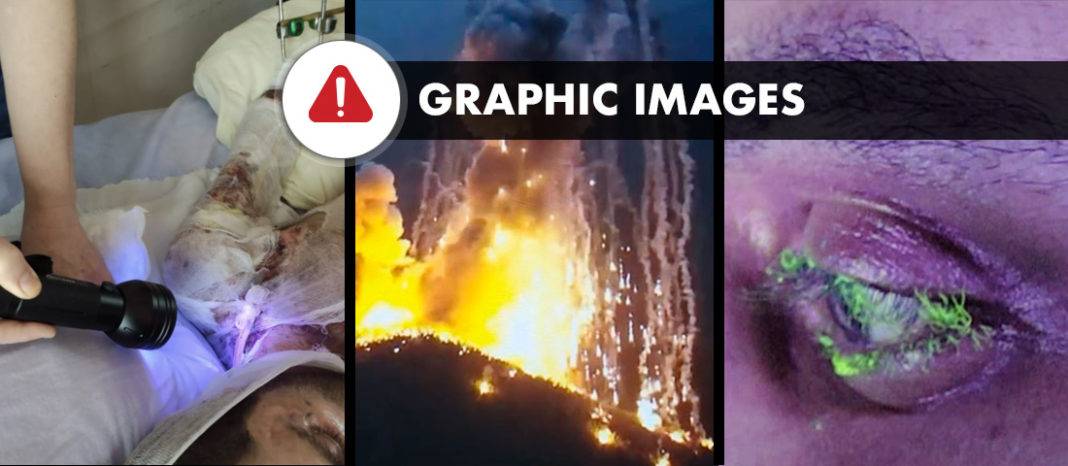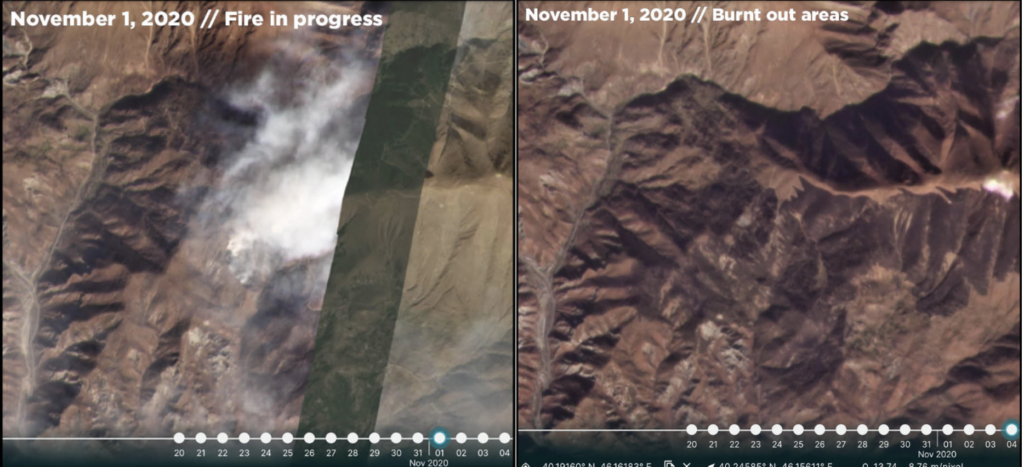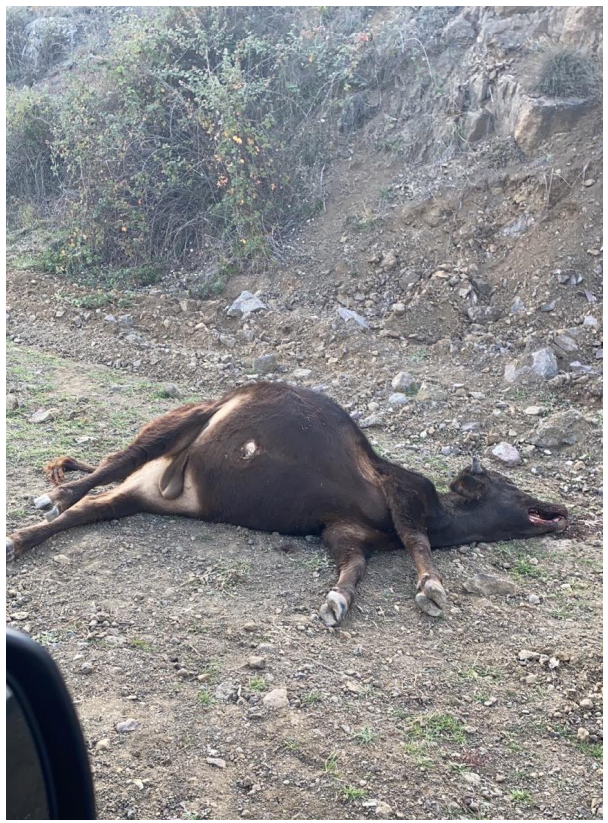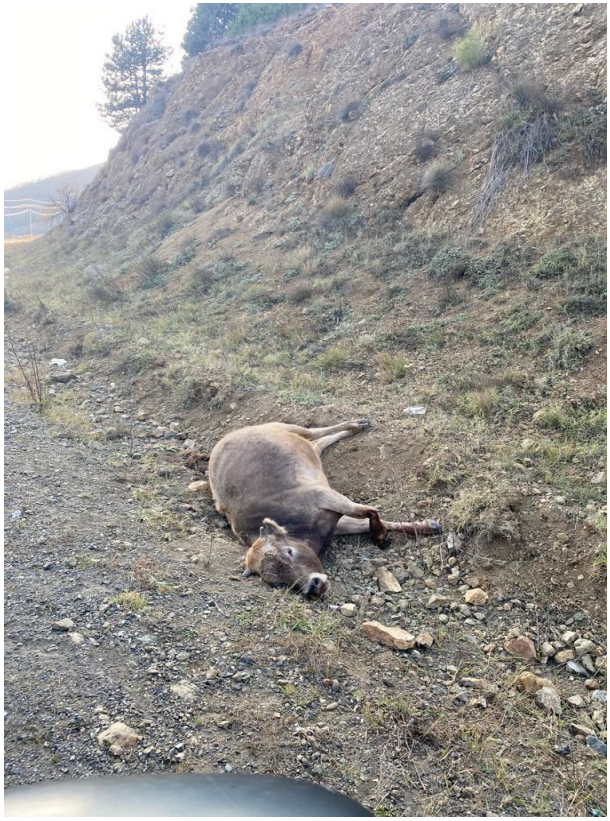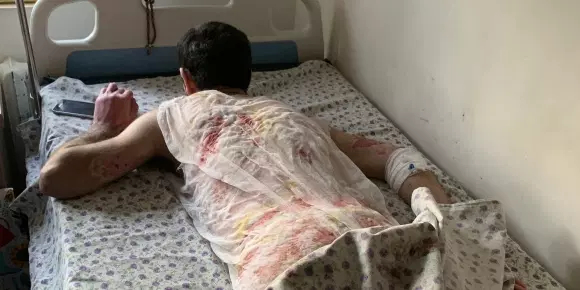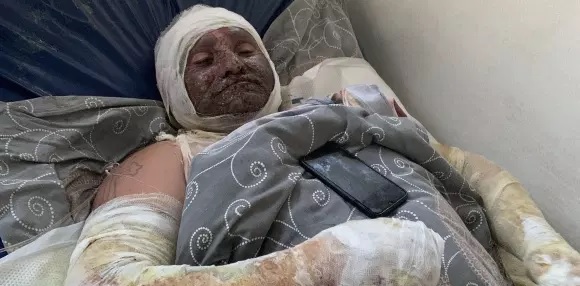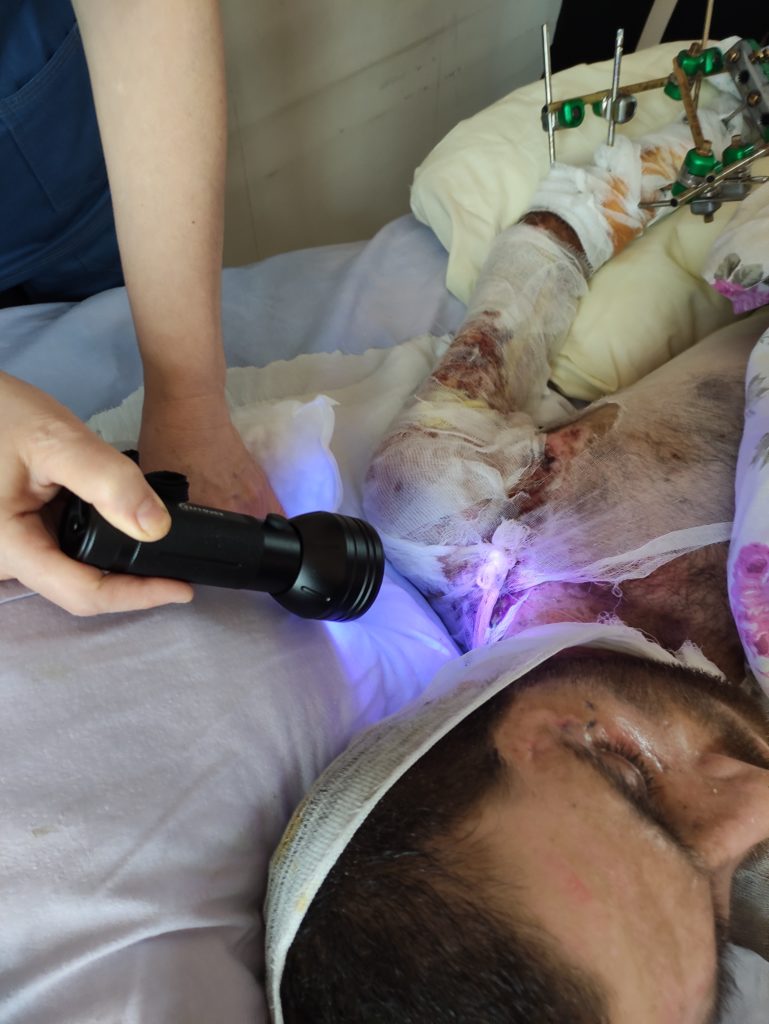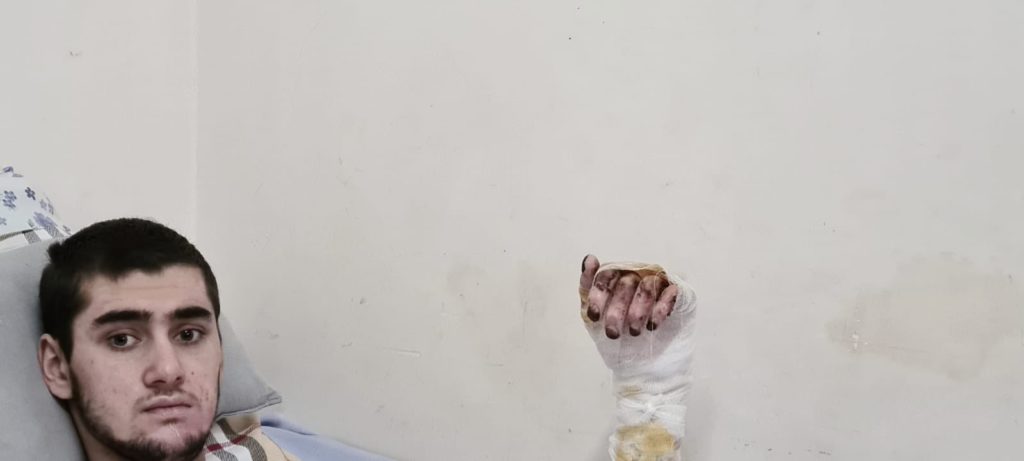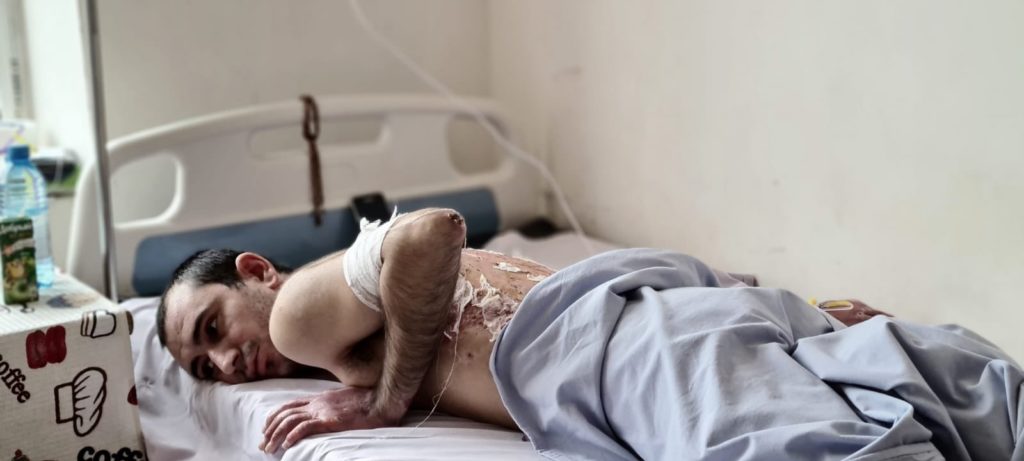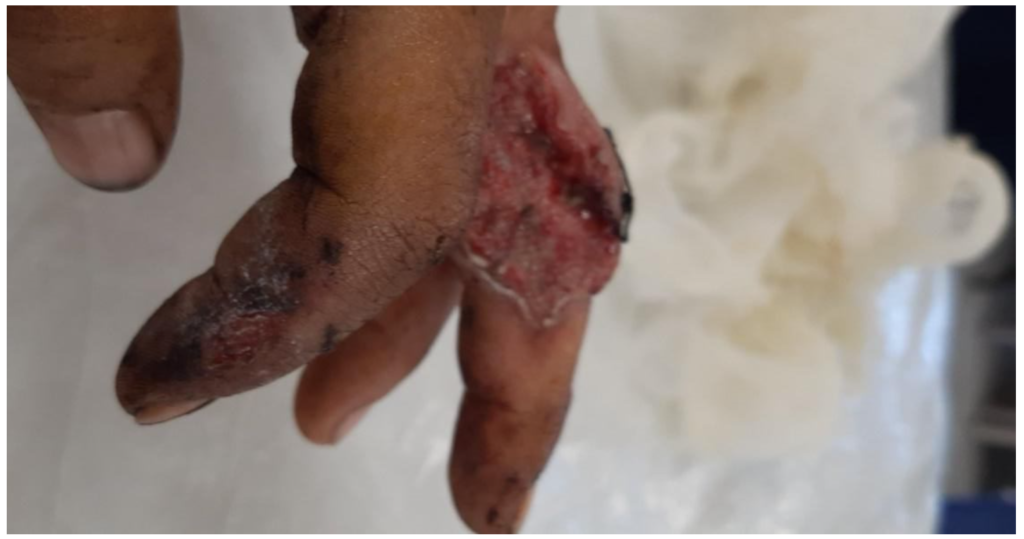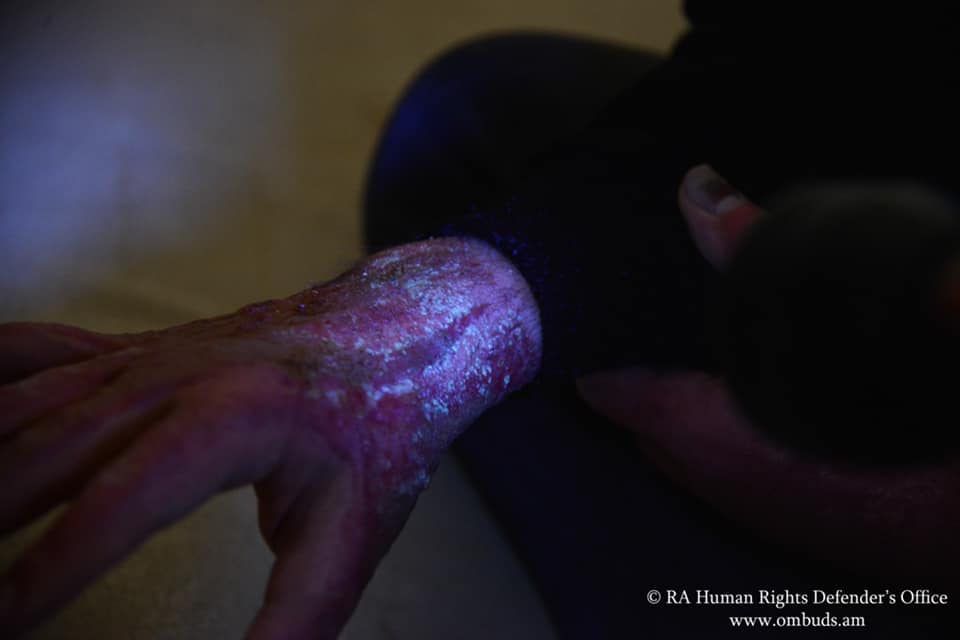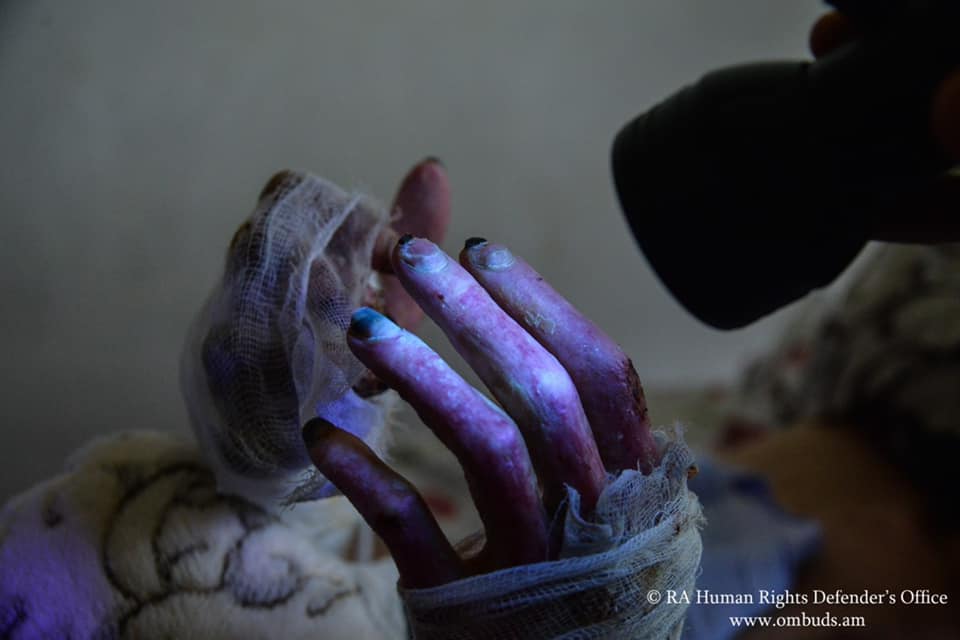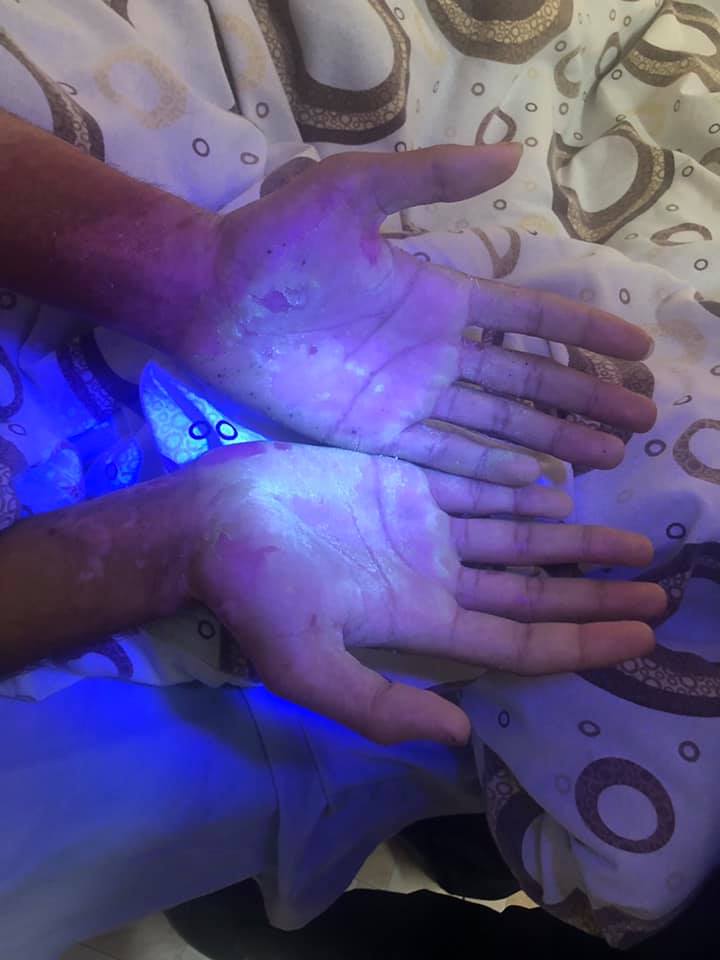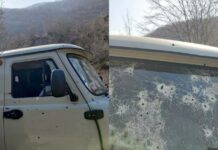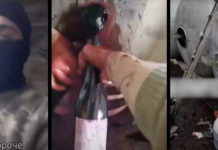Evidence of white phosphorus incendiary attacks on Artsakh/ Nagorno-Karabakh by Azerbaijan emerged in the last week of October 2020 — a month into the violent and bloody war — following rumors about fires raining down on the forests of the Republic of Artsakh. The de facto independent state controlled by ethnic Armenians became the target of indiscriminate scorched-earth tactics by the neighboring state that claimed those lands to be theirs by “law”, and the ethnic Armenians populating them for millennia to be “alien invaders”.
Since internet/communication lines were damaged, it wasn’t until October 29, 2020, that the first video evidence of burning villages reached the outside world. In the following days more evidence of air-delivered incendiary weapons emerged. At that point, it was clear that Azerbaijan was prepared to unleash ecological and humanitarian devastation to seize control of the sovereign region over which it had lost authority decades ago.
On November 2, 2020, fifty one NGO’s in Armenia issued an Ecocide Alert for Artsakh/Nagorno–Karabakh condemning the use of incendiary weapons by Azerbaijan. The urgent call to action to prevent an imminent environmental disaster, fell on international community’s deaf ears; Azerbaijan fiercely denied the attacks while mirroring accusations towards the Armenian side.
Chronological Evidence
The first visual evidence of burning villages was shared by the Artsakh Ombudsman, Artak Belgaryan on his twitter account on October 29, 2020. The video shows mass destruction of civilian infrastructure and massive smoke vortices initiating from the village. Although the thick smoke screens may indicate the use of incendiary weapons, there is no verified account on when and how the village was set fire to.
L: Google Maps – Aknaghbyur/Ağbulaq in Artsakh/Nagorno-Karabakh
R: Crisis Group – Map showing the borders of the former NKAO and NKR controlled regions of Azerbaijan. The locator pin indicates the position of the village Aknaghbyur
On October 16, 2020, Ilham Aliyev had announced the “liberation” of a number of villages, including “Ağbulaq” which is the Azerbaijani name for the village of Aknaghbyur. On October 30, 2020, the day after sharing the video of the burning village, Artak Belgaryan announced casualties among the civilians of the village, accusing Azerbaijan of “deliberate/indiscriminate targeting of civilian areas & population” by “shelling”.
Regardless of the vehicle, this example illustrated that Azerbaijan was prepared to use scorched-earth tactics prohibited by the 1977 Protocols Additional to the Geneva Conventions of 12 August 1979. It is important to note that Aknaghbyur is a village in the Askeran province within the borders of the former Nagorno Karabakh Autonomous Republic (NKAO) — the ethnic Armenian autonomous enclave within Soviet Azerbaijan.
The first footage attesting to the use of air-delivered incendiary weapons, possibly white phosphorus (WP), in Artsakh/ Nagorno-Karabakh started circulating on October 30, 2020. It was shared on the Telegram channel of the Russian war correspondent Sasha Kots, who writes to have received the footage of what looks to be white phosphorus, from local eyewitnesses. The source comments that “phosphorus” was used a couple of days before October 30 in the densely forested northern areas and the forest was burning for days; she was on the phone with her husband when the captured attack took place.
Firs video evidence of air-delivered incendiary attacks on Artsakh/Nagorno-Karabakh by Azerbaijan
As the footage started to circulate on social media, several military analysts recognized the weapon as possibly “banned white phosphorus” due to the characteristic flare, thick smoke and the rain of fire, as Human Rights Watch (HRW) described the incendiary weapon in their 2009 review on Israel’s use of white phosphorus in Gaza.
“White phosphorus (WP) is an incendiary and toxic chemical substance used as a filler in a number of different munitions that can be employed for a variety of military purposes.”
– Geneva Academy’s Weaponslaw.org
White phosphorus (often referred to as WP) is a chemical compound that ignites upon exposure to oxygen, generating intense heat, yellow/white light and thick smoke. It is often used as a component in smoke generators and signal flares. But more often, white phosphorus is employed as a filler in incendiary munition used for the purpose of destroying military objects and infrastructure, flush combatants out of forested areas that serve as natural anti-drone tactical assets.
Indiscriminate use of incendiary weapons is prohibited under the 1980 Geneva Convention on Certain Conventional Weapons. However, in practice, the legal loopholes in the convention are often exploited to justify purposeful harming of civilians, infliction of damage to the civilian infrastructure, environment and life stock essential to the survival of the civilian population. These so-called offensive scorched-earth tactics have proven to be effective military strategies for quick territorial gains — the environmental devastation inevitably leads to ethnic cleansing.
The second footage in close-up attesting to the use of air-delivered incendiary weapons (possibly white phosphorus) over Artsakh/ Nagorno-Karabakh was released by the Artsakh Ministry of Defense (MoD) on October 31, 2020, showing mass destruction of the forests in Armenian controlled regions.
Second video evidence of air-delivered incendiary attacks on Artsakh/Nagorno-Karabakh by Azerbaijan
In the following days, more evidence surfaced. On November 2, 2020, the documentary makers of Bars Media released a video showing Artsakh soldiers at a military post being caught off guard by an attack by incendiary munition. Judging from the nonchalant reaction, the soldiers were unaware of the imminent danger: “I saw [the weapon] for the first time a couple of days ago”, tells one of the soldiers, as they casually resume their lunch (full video).
Third video evidence of air-delivered incendiary attacks on Artsakh/Nagorno-Karabakh by Azerbaijan – Bars Media
The aftermath of the incendiary attacks
The incendiary attacks on Artsakh/Nagorno-Karabakh have brought devastation to the nature and the people. Below, the ecological and human tolls are assessed individually.
Ecological toll
On November 12, 2020, Atlantic Council’s Digital Forensics Research Lab (DFRLab) published the results of their satellite imagery investigation confirming that the fire damage was exclusively in forested areas controlled by the Armenian side at the time of the attacks. DFRLab investigated two areas in Artsakh/Nagorno-Karabakh. Area #1, in the northwest of the village of Dadivank, located between the villages of Shikaqar (Sarıdaş), Yeghegnut (Qamışlı) and Nor Getashen (Nadirxanlı); and Area #2, between Karing (Arpagədik), Spitakashen (Spitakşen) and Petrosashen.
Satellite images of Area #1 (L) and Area #2 (R) during and after the fire. The dark ares indicate extensive burn marks – DFRLab
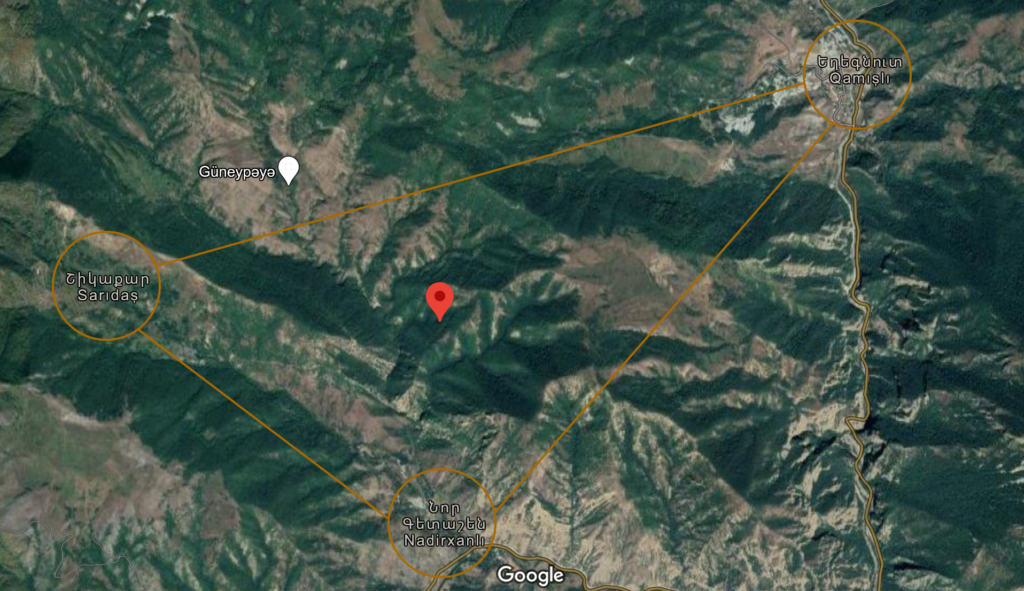
Source: Google Maps – Area #1, Shikaqar, Yeghegnut and Nor Getashen 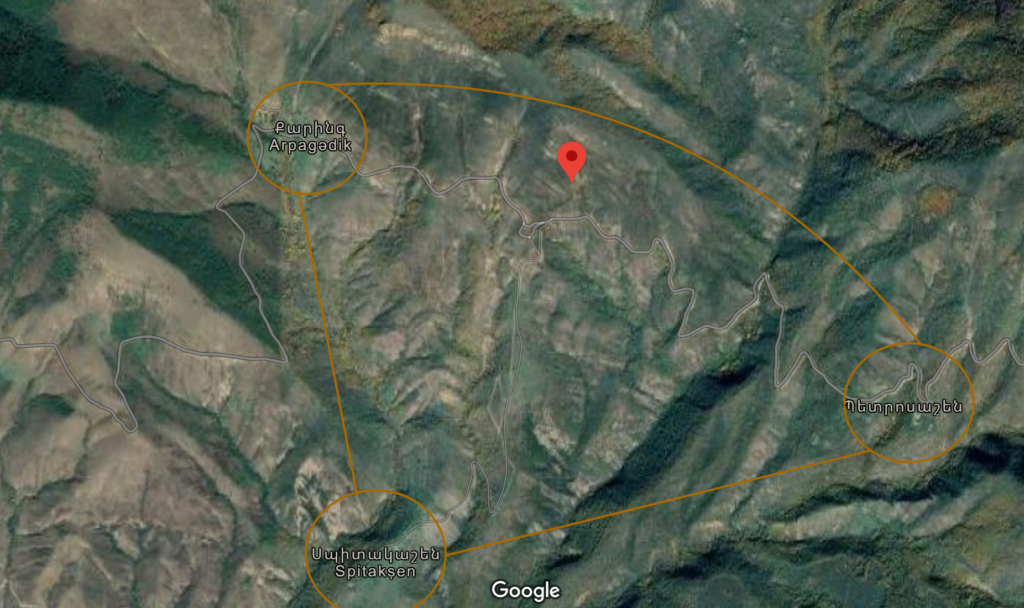
Source: Google Maps – Area #2, Karing, Spitakashen and Petrosashen
Areas in Artsakh/Nagorno-Karabakh investigated by the Atlantic Council’s DFRLab
According to the DFRLab’s report, inspection of satellite images taken on September 30, 2020, (pre-fire) and on November 1, 2020 (post fire) confirms that large forested areas were “extensively” damaged by fire. Burn marks covering vast forested areas are visible as darkened areas on the post-fire imagery.
From the Google maps images above, it is quite clear that Area #1 and #2 are each in the vicinity of at least three villages. Both territories are far into the borders of the former NKAO and not the occupied regions. As such, incendiary attacks on the territory could not have possibly allowed a distinction to be made between military and civilian objects.
DFRLab reported that the investigation did not support the allegations of similar use of incendiary weapons by the Armenian side in Azerbaijani controlled areas. DFRLab had previously investigated similar cases attesting to the use of incendiary weapons (WP) in Idlib, Syria.
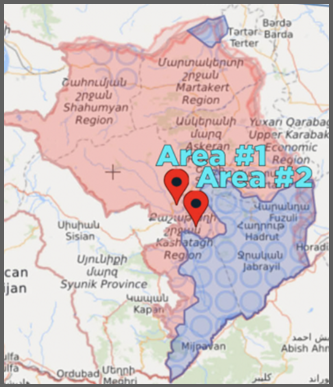
Source: DFRLab – satellite imagery reveals “extensive burn marks” in two investigated areas on Armenian controlled territory in Artsakh/Nagorno-Karabakh

Map of areas affected by Azerbaijan’s incendiary attacks.
Artsakh Ombudsman – Ad Hoc Public Report On the Use of Incendiary Ammunition
According to the Ombudsman of the Republic of Artsakh, at least 1815 HA of forest was destroyed as a result of Azerbaijan’s indiscriminate shelling with incendiary weapons. Extensive damage was found near at least a dozen of villages in the indicated areas, some of which were located within a 100 meters of burning forests.
The scorched-earth offensive employed by the Azerbaijani Armed Forces, left the areas devastated and cleansed. The villages that depended on the forests and the livestock for their survival had to chose between staying and facing an ecological and humanitarian crisis — especially with the winter nearing –, risk to witness a potential bloody takeover by the advancing Azerbaijani forces, or leave. Some of those who left, travelled through or hid in the forests seeking cover from hunter-drones, but ended up ambushed by incendiary weapons.
Animals (livestock) near the affected villages, killed as a result of incendiary attacks on Artsakh/Nagorno-Karabakh by the Azerbaijani Armed Forces.
Artsakh Ombudsman – Ad Hoc Public Report On the Use of Incendiary Ammunition
Human toll
The ecological disaster caused by the incendiary attacks on Artsakh/Nagorno-Karabakh has destroyed the flora, fauna and the civilian infrastructure essential for the survival of the villages in the vicinity of the affected areas. Moreover, the forests were used as a hideout not only by combatants — as the Ombudsman reports, many civilians who fled their villages escaping hostile take over by the Azerbaijani army, hid in the woods or traveled through them in order to avoid being targeted by hunter-drones. The attacks on the woods has caused casualties among both civilians and combatants. Those who made it to hospitals, are suffering from fourth- and fifth-degree burns.
“[White phosphorus] can cause death and horrific injuries to humans. White phosphorus in particular is highly soluble in fat, and thus in human flesh. When it comes in contact with skin, it produces severe thermal and chemical burns, often down to the bone, that are slow to heal and likely to develop infections. Because white phosphorus continues to burn if exposed to oxygen, wounds that have been cleaned and dressed can reignite when dressings are removed. White phosphorus can also enter the bloodstream through the burns and cause multiple organ failure. For this reason, burns on only 10 percent of the body are often fatal.”
FRANCE 24, a French international news network, visited a burn unit in a hospital in Yerevan, where the personnel is said to be “struggling with the influx of patients”. French aid worker helping at the unit describes the burn injuries as something they have never seen before.
“It eats the flesh, down to the bone and further through it”
One of the doctors characterizes the wounds as chemical, i.e. a chemical substance (white phosphorus) reacts with the oxygen in the air and the fat in the flesh, maintaining and aggravating the burning process. In contrast, physical burns result from (in)direct exposure to heat/fire and the process that causes the injury upon and after exposure, is thermal. In the latter case, the burning process is halted by removing the heat source and cooling the injury, whereas in case of white phosphorus (chemical) injuries the burning process is sustained through reaction with oxygen and fat.
FRANCE 24 coverage at the burn unit at a hospital in Yerevan
Even if treatment manages to halt the burning process, white phosphorus burn injuries previously thought to be healing often reignite when the external conditions enable re-initiation of the chemical process. Patients also experience respiratory problems due to damage inflicted to the airways by inhaling the toxic chemicals, as well as internal burns, metabolic problems and multiple organ failure when the toxic compounds enter the bloodstream. According to an HRW report, patients suffer from “excruciating pain”.
The medical treatment itself — debridement — is “extremely painful” and exposes the patients to an increased risk of infection. Patients with 10-20% of affected total body surface area (TBSA) are likely to suffer a fatal shock. As the French doctor in the FRANCE 24 coverage explains, the toxic nature of the chemical and the severe injuries it causes, makes WP burn patients extremely difficult to treat and poses dangers to the medical personnel if no proper safety precautions are taken.
L’Obs special correspondent Sara Daniel covers her visit to a burn unit at a hospital in Yerevan (translated from the L’Obs article published on November 13, 2020):
“
Karine Babayan, the deputy director of Erevan Hospital specializing in the treatment of burns is a fragile young lady who has a hard time staying calm as words jam in her mouth while she is showing the photos of the patients with gaping flesh and pulverized bones and is handing protective gears to us. ‘At first, we did not comprehend what was going on’, she tells us, ‘we have never encountered anything like that before. These burns did not heal. The patients were having convulsions. On the 12th day, their state would get worse and at the end of 17th day they would pass away from cardiac arrest. We have lost many young soldiers.
We did not know how to treat this.’
Dozens have died here, and the doctor is raged at her own ignorance and helplessness. Young people who were fulfilling their military service were enlisted in this war of unequal forces, where death came directly from the sky. One of them is Meroujan Katchinian, 18 years old who lies on his stomach as his back is severely burnt, or Souren Markarian, 23, whose face is not even recognizable. They occupy an entire wing of the hospital and suffer from a pain that reaches their bones. Gevorg Ginossian, 25, had 70 percent of his skin burnt. On November 1, in Mardouni the young man did not see it coming, a bomb dropped by one drone detonated his car, and the second — the convoy of four vehicles. Almost all of the soldiers did not survive. Despite his exhaustion, he finds a way to joke:
‘Those bombs, have everything you might think of, a real bag full of surprises‘.
When on November 7 Karine Babayan spoke of these wounds which do not heal with the team of doctors who came from France, Patrick Kneipper, orthopaedic surgeon from Public Assistance-Paris Hospitals and a specialist in severe burns took the decision to come and see the patients. The deep lesions which continue to get worse, hypocalcaemia (abnormal drop in calcium levels in the blood), sudden deaths, secondary deaths, metabolic disorders, would, according to him, strongly suggest that these injuries are results of white phosphorus.“
”
Sara Daniel for L’Obs
(November 13, 2020, Yerevan, Armenia)
Patients at the burn unit of a hospital in Yerevan, Armenia – November 13, 2020, article by L’Obs special correspondent Sara Daniel.
(Jérôme Sessini/Magnum Photos for L’Obs)
White Phosphorus is a luminous substance that emits light when it absorbs high energy electromagnetic radiation, such as Ultraviolet. Phosphorus thanks its Greek name to the eery green glow it has in the presence of oxygen. For example, ‘glow-in-the-dark’ stickers and paint are phosphorescent, easily identifiable by the characteristic bright green glow. White phosphorus traces are detectable — inspecting the burn injuries using UV-light draws a harrowing picture.
The burn victims at the Yerevan hospital will take months, years, to heal their wounds, if they survive
Anne-Laure Bonnel is an independent French photojournalist
Fin DePencier is an independent Canadian photojournalist
“Here sighs and cries and shrieks of lamentation
echoed throughout the starless air of Hell;
at first these sounds resounding made me weep”
-An excerpt from Dante’s Divine Comedy
“According to the doctors, the injuries observed give a clue to the nature of the weapon used. ‘What we are assuming is that there are burns caused by either phosphorus or other chemicals’ “
by Anne-Laure Bonnel
In her December 16, 2020, article for The Independent, Liz Cookman writers about her visit to the burn centre in a Yerevan hospital. Deputy director of the unit, Karine Babayan tells that in the first weeks, the horrible wounds were a mystery to everyone working at the hospital. The injuries were unfamiliar and the medical personnel started to notice other problems, such as respiratory issues, heart and kidney failures and bleeding with no apparent wounds. When the first visual evidence of white phosphorus attacks in Arstakh/ Nagorno-Karabakh emerged, the medical personnel started to look into the literature on white phosphorus injuries, recognizing the clinical profile. In retrospect, Babayan tells to Cookman that they may have been encountering white phosphorus injuries as early as the start of the Artsakh/ Nagorno-Karabakh war in late September, without understanding it at the time.
“The first three days were very stressful as so many were hospitalised. The doctors were doing their work then going to their rooms and crying.”
Deputy director of the burns centre in Yerevan, Karine Babayan
“
With eyes wide from trauma, almost every part of Arman Salmanyan’s body is covered in bandages and after two months of treatment he is not getting any better – this, the doctors say, is the effect of incendiary weapon white phosphorus. […..]. Now bed-ridden at the National Burns Centre in the Armenian capital Yerevan, Salmanyan has had surgery three times to graft skin from his legs onto his hands, but there is still no progress. He says he dreams of running, again, but he is currently unable to do anything for himself and his parents rotate spending 24 hours a day at his side. He is not able to sit or walk, and the doctors don’t know if he ever will as it’s the first time they have dealt with these sort of injuries.
“I don’t feel angry about anything or anyone because of what happened to me because this is war. But I want the world to ban and condemn the use of these munitions.“
Arman Salmanyan
[…]
[Suren (23)] says his car was hit with an Israeli kamikaze drone that was carrying the incendiary near the front line, killing his commander and two other soldiers. Still pacing in pain two-and-a-half months later, Suren’s friend tries to pull a loose thread from the bandages on his leg and it immediately catches fire as it drags along his burnt skin.
“Suren underwent surgery, the wounds recovered and then the old wounds reopened. He is still here and not recovering. Our soldiers were treated like dogs for experiment“, says Babayan.
“
Liz Cookman for The Independent
(December 16, 2020, Yerevan, Armenia)
Next to the burn injuries, Cookman reports, the soldiers have fractures, problems with hearing and seeing caused by nearby explosions, as well as post-traumatic stress disorder (PTSD). Their families and friends suffer along, but have to control their emotions to be able to take care of their injured.
“
Svetlana Meliksetyan, 39, from near Yerevan, has only been home twice since her only son Vartnes Hovakimyan, 19, was burnt with an incendiary on October 15. “They were left burnt by for one day until the doctors could get to them because no one knew where they were” she says, her voice wavering in pain and tears filling her tired eyes. […]
“I want no mother to feel what we feel, no matter what country they are from”
Svetlana Meliksetyan
“
Liz Cookman for The Independent
(December 16, 2020, Yerevan, Armenia)
AFP Global News Agency coverage at the burn unit in Yerevan, Armenia
The report released by Human Rights Ombudsman of the Republic of Artsakh reveals horrific images. The Ombudsman of the Republic of Armenia shared a gallery of harrowing images on social media after his visit to one of the burns units.
Armenian/Artsakh civilians and soldiers with horrific burns treated at hospitals in Yerevan, Armenia. Inspection under blacklight reveals traces of phosphorus in bright green. Photos published by Republic of Artsakh Ombuds and Republic of Armenia Ombuds
International Law
The legal basis for protection of civilians against incendiary weapons has been laid through a combination of international treaties, customary international humanitarian law and case law.
Protocols Additional to the Geneva Conventions of 12 August 1949 are amendments to the humanitarian law relating to the protection of victims of both international and non-international armed conflicts. The protocols stipulate that the civilian population, individuals and objects shall not be the object of attack, prohibiting acts of violence and terror, not only in light of direct physical harm or damage to civilian objects, but also in regard to “protection of objects indispensable to the survival of the civilian population”, such as agricultural areas, livestock and drinking water sources. The evidence presented above indisputably attests to Azerbaijan’s indiscriminate targeting of civilian population and objects indispensable to their survival, demonstrating utter disregard for international humanitarian law.
The Protocol on Prohibitions or Restrictions on the Use of Incendiary Weapons (Protocol III) of the United Nations Convention on Certain Conventional Weapons (CCW) concluded at Geneva in 1980, defines an “incendiary weapon” as “any weapon or munition which is primarily designed to set fire to objects or to cause burn injury to persons through the action of flame, heat, or combination thereof, produced by a chemical reaction of a substance delivered on the target.”.
This CCW definition of incendiary weapon introduces a loophole in the law as it excludes weapons that contain incendiary fillers but are primary designed for other purposes, such as signal flares and smoke screens. This gives weapon developers and malevolent users a carte blanche to exploit the loophole by redefining the purpose of their product. HRW has been advocating for closing this loophole for years. In any case, the visual evidence of the incendiary attacks by Azerbaijan, undeniably excludes other than incendiary as a primary purpose.
Article 2 of CCW Protocol III stipulates that it is prohibited in all circumstances to make the following targets the object of an attack by incendiary weapons: 1) civilians and civilian objects; 2) military objectives within a concentration of civilians by “air-delivered” attacks and 3) other than air-delivered attacks, unless precautions are taken to limit the attack to the military objectives alone, avoiding incidental civilian casualties and damage to civilian objects; 4) forests and other natural assets, unless these assets are military objectives or are being used to conceal them.
Eyewitness accounts by victims, backed by visual evidence attests to air-delivered attacks on civilian objects, objects indispensable for civilian survival and military objects within civilian areas, in direct violation of points 1 and 2 of Article 2. Though forests did offer combatants natural anti-drone cover, there’s no sensible argument to qualify such vast forested areas as exclusively military objects.
Since WP is toxic, its use can under certain circumstances be considered prohibited under the Chemical Weapons Convention (CWC) of 1992. Although there is a legal debate about whether white phosphorus can be considered “specifically designed to cause death or other harm through the toxic properties”, there is evidence that some governments considered the use of white phosphorus as a chemical weapon.
Azerbaijani mirroring propaganda playbook
On October 31, 2020, the day after the first visual evidence of Azerbaijan’s use of incendiary weapons emerged, Turkish and Azerbaijani news outlets started to circulate unfounded allegations of “Armenia preparing to use white phosphorus”.
Some journalists quickly recognized the mirroring tactics so often used by Azerbaijani and Turkish government representatives to create an information fog, distract from factual evidence of war crimes and facilitate bothsideist narratives preferred by the international media.
When evidence of incendiary attacks surfaced, Hikmet Hajiyev, the Azerbaijani spox, accused Armenia of pulling off a false-flag
The same day, Hikmet Hajiyev, the Azerbaijani president Ilham Aliyev’s spokesperson, accused Armenia of using phosphorus to “cause[d] fire in Shusha forests […] to create white smoke and hinder vision of drones used by Azerbaijan’s armed forces”, calling it a “sign of desperation”. In other words, Azerbaijan denied involvement and accused Armenia of committing a false-flag white phosphorus attack on Artsakh/ Nagorno-Karabakh.
Lindsey Snell is an independent journalist specializing in conflict and humanitarian crises in MENA, in particular Syria and Turkey. Snell was the first to disclose primary source information on the deployment of SNA mercenaries by Turkey to Artsakh/Nagorno-Karabakh weeks before the war started. Snell has been covering the 2020 Artsakh/Nagorno-Karabakh War as an author for The Investigative Journal
Modern military Unmanned Aerial Vehicles (UAVs) are equipped with Synthetic Aperture Radar (SAR) Imaging sensors that can “see through” optical obscurants; or Forward-Looking Infrared (FLIR) Imaging (or other thermal imaging) sensors that can detect emitted thermal radiation or reflected IR radiation through fog/smoke. What these sensors can’t see through is dense objects, such as trees and forests.
Forests, especially in mountainous areas, are natural military tactical assets and provide essential coverage against aerial attacks and reconnaissance. The most casualties suffered by the Armenian side were due to Azerbaijani drone strikes. The allegation of destroying a permanent anti-drone cover to create a temporary one was met with ridicule on social media platforms. Although this may have helped to halt the ‘false flag”-narrative, it did not discourage Hajiyev from carrying out a full-out gaslighting and mirroring campaign in the days to come.
Hikmet Hajiyev moulds the public opinion, in preparation for the upcoming mirroring campaign, by alleging that Armenia supposedly has a history of using WP against Azerbaijan. This accusation is unsubstantiated
Azerbaijan presents supposed proof of an alleged incendiary attack on Fuzuli. What the pictures actually show is explosives experts preparing a single WP ammunition shell for remote detonation
The decomposition of the UXO by experts was subsequently recorded as well — this video does NOT show the alleged attack on Fuzuli
On November 2, 2020, Hajiyev alleged that Armenia had used white phosphorus munition in the 2016 clashes, by sharing old pictures (L) of a team of explosives experts working to secure and decompose an Unexploded Ordnance (UXO), supposedly fired by the Armenian side. While the experts are carrying out the dangerous task, a group of (foreign) media representatives lead by Hajiyev himself, are watching the process, incautiously up close.
Within an hour after alleging that Armenia has a history using WP against Azerbaijan, Hajiyev shared pictures (M) and a video (R) showing, again, explosives specialists carrying out a controlled detonation of a single unexploded WP ammunition supposedly fired by the Armenian side. According to Hajiyev’s tweet, the neutralization took place on October 8, 2020 — four weeks before his announcement.
In the next two days, on November 3 and 4, 2020, Hikmet Hajiyev shared more pictures of explosives experts securing a white phosphorus UXO. The common picture: the explosives expert digs a deep hole, buries the UXO for subsequent remote detonation.
The common denominator of the alleged attacks on Fuzuli, Tartar and Sehlabat seems to be the incompetence of the, supposedly, Armenian-fired WP munition: they always land as single UXOs and systematically fail to realize their design purpose
Another video released on November 3, 2020, shows reporters standing by, ready for the explosives team to detonate the shell. “Attention… Ready…” — the countdown is followed by an explosion in the field behind the media crew as the producer shouts “Action!” and the cameras start rolling. Another video shared on November 18, shows a similar display of a controlled decomposition in a field.
“Ready… Roll Camera Action!”
It should be emphasized that the 2020-accusations by Azerbaijan regarding the use of white phosphorus by the Armenian side were practically identical to the allegations made during the 2016 clashes. The same playbook: Azerbaijan accused the Armenian side of using WP munition with Hikmet Hajiyev leading the campaign, followed by a release of pictured and a video depicting a controlled detonation of a single unexploded WP shell by explosives experts in the close presence of the press. Some news outlets covered the show (see the video below). Identical to the 2020 case, the Azerbaijan never supported its allegations by factual evidence of an actual attack, damage or casualties.
Azerbaijan accuses Armenia of using WP ammunition; the video shows a controlled neutralization of allegedly a WP UXO by a group of experts in the presence of the (inter)national media and representatives at an irresponsibly close proximity; during the 2016 clashes in Artsakh/Nagorno-Karabakh
In conclusion, a thorough investigation of the “evidence” presented by the Azerbaijani side reveals a clear pattern: for some inexplicable reason the white phosphorus projectiles allegedly fired by the Armenian side always land as single shell, consistently fail to explode and have to be detonated by experts in the presence of (inter)national reporters and representatives. All the while the incendiary attacks by the Azerbaijani side are caught on camera while the exploding clusters rain down on the Armenian controlled territories, unambiguously causing humanitarian and ecological devastation. As such, the Azerbaijani side has systematically failed to present any evidence of damage to the land or people as a result of these alleged attacks by the Armenian side.

